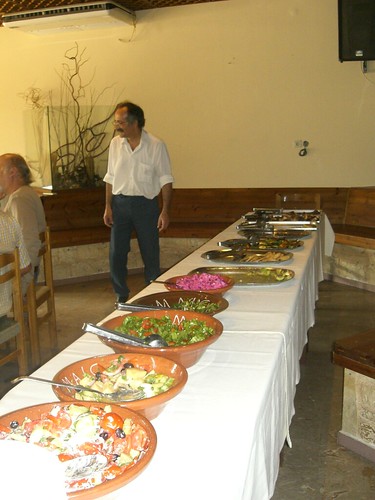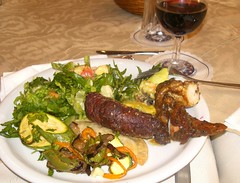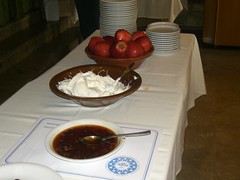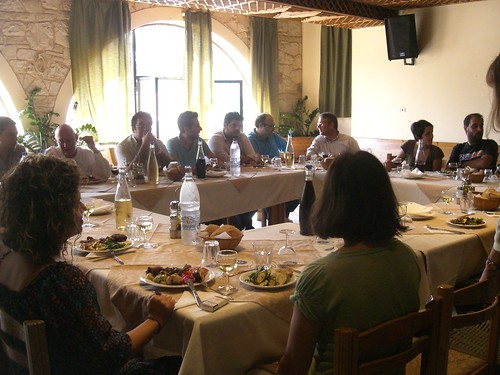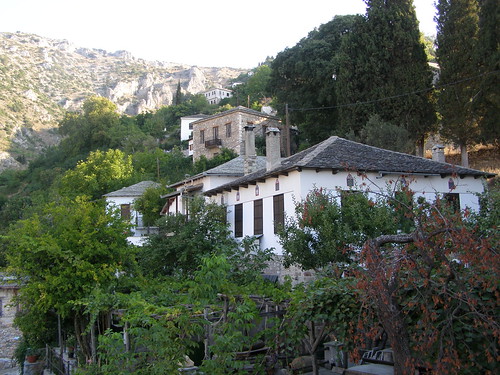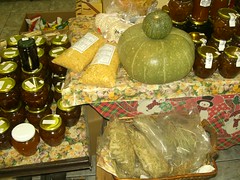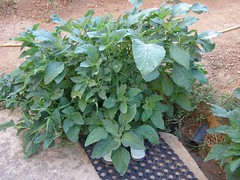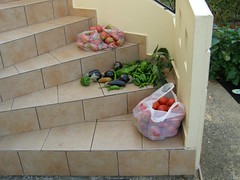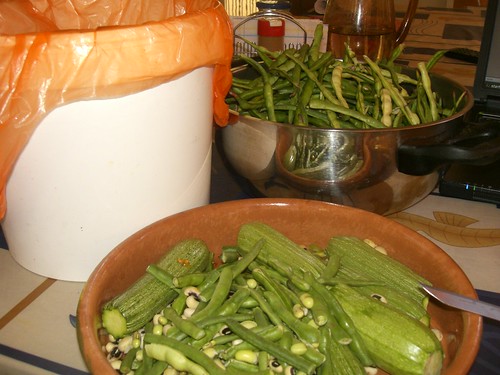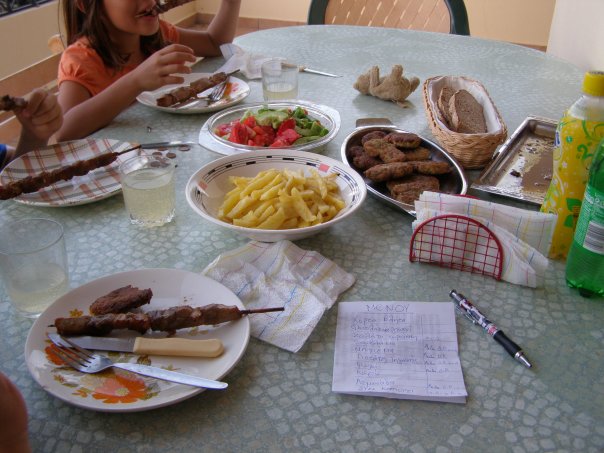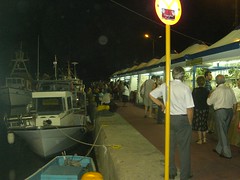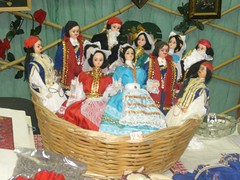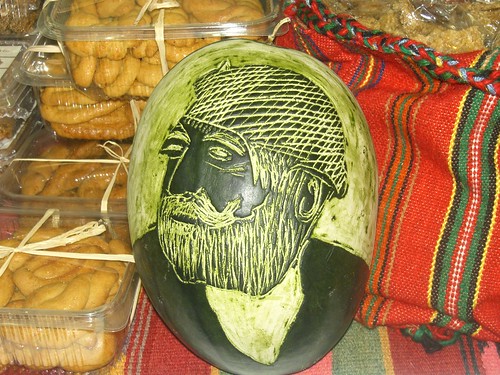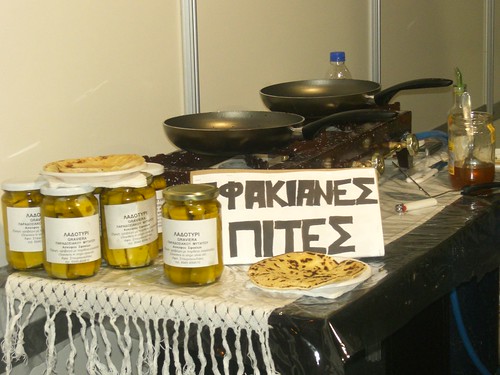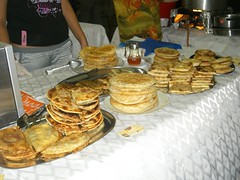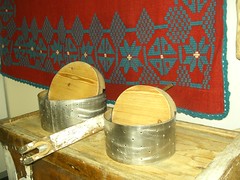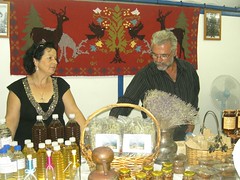A while back, I had posted a photo on my facebook page, which looked slightly incongruous, given the setting where I had taken it. I posted it as a teaser and I asked people to say how this photo made them feel.
Fennel salads, couscous, soups in the summer, (the cursed) kids' menus (as if kids don't eat the same things grown-ups eat), curry flavours and a preponderance of French cuisine terms do not immediately make us think of traditional eateries in Crete, so we probably can't label this place a taverna. Only the last two choices (octopus and shrimp) which are singled out in a different colour remind us of something a Greek summertime taverna would serve: both octopus and shrimp are common choices in a seaside eaterie in coastal Greece.
Not only the choices on the menu, but also the writing style, suggest that there is something non-Greek going on here: the curly script is reminiscent of Northern European writing styles. It takes a little getting used to if you are not familiar with hand-written English in this calligraphic style; even if those swinging S's make you dizzy, they are certainly eye-catching enough to tempt you to come closer to have a better look. Without closer inspection, the average Greek might take it for Arabic!
We have probably ascertained that the cook isn't Greek, but what about the customers? The menu conveys a sense of any time and any place. International cuisine is usually the domain of restaurants in the Western world, and most of us do in fact go out to dine on international food. But there are also a good number of us who like to cook according to the cuisine style of a culture that is not our own. We don't wait to go to Italy, for example, to have pizza. That's why I like to cook Asian dishes; if I waited to visit Asia to try Asian cuisine, I probably won't eat anything Asian for the next decade at least! There are many of us who are really tired of the classic Greek taverna menu and would like to try something different.
Despite resembling a bit of a melange, this menu conveys an originality that the average Greek taverna menus do not. This kind of menu fits the bill for those of us who would like to try something different when we go out. Personally, I'd have no hesitation in ordering the taboulleh and chicken curry, and I know which members of my family would be interested in the pepper steak, the schnitzel and the pizzas. (But forget the soups - not really very Greek to have those when going out for a meal, and certainly not in the summer!)
The truth remains however that, on first sight, such a menu card on the south coast of Crete, in a quiet less popular summer resort town with not many tourists or even locals, would probably cause some confusion. For a start, we don't expect to see such an array of dishes being served in this locality. Secondly, there is already the price stigma attached to international menus in places like Greece - such menus are usually more expensive than the average Greek taverna. This is what would actually stop me from coming too close to the restaurant's entry: I am not given an idea about how much I will be paying to enjoy such a menu, so I don't really know if I am in a position to afford it...
If I put aside price though, I know I would be happy to try this menu. Since I often cook international dishes myself, I know how easy it is to serve up these meals in my own home. You don't need special ingredients to do this, in the sense that you can go to the supermarket and find practically everything you need to create these dishes using local and imported ingredients. All you need is an enthusiastic chef.
©All Rights Reserved/Organically cooked. No part of this blog may be reproduced and/or copied by any means without prior consent from Maria Verivaki.
 |
| Sighted outside an eaterie in Souyia, located on the south coast of Crete |
Not only the choices on the menu, but also the writing style, suggest that there is something non-Greek going on here: the curly script is reminiscent of Northern European writing styles. It takes a little getting used to if you are not familiar with hand-written English in this calligraphic style; even if those swinging S's make you dizzy, they are certainly eye-catching enough to tempt you to come closer to have a better look. Without closer inspection, the average Greek might take it for Arabic!
We have probably ascertained that the cook isn't Greek, but what about the customers? The menu conveys a sense of any time and any place. International cuisine is usually the domain of restaurants in the Western world, and most of us do in fact go out to dine on international food. But there are also a good number of us who like to cook according to the cuisine style of a culture that is not our own. We don't wait to go to Italy, for example, to have pizza. That's why I like to cook Asian dishes; if I waited to visit Asia to try Asian cuisine, I probably won't eat anything Asian for the next decade at least! There are many of us who are really tired of the classic Greek taverna menu and would like to try something different.
Despite resembling a bit of a melange, this menu conveys an originality that the average Greek taverna menus do not. This kind of menu fits the bill for those of us who would like to try something different when we go out. Personally, I'd have no hesitation in ordering the taboulleh and chicken curry, and I know which members of my family would be interested in the pepper steak, the schnitzel and the pizzas. (But forget the soups - not really very Greek to have those when going out for a meal, and certainly not in the summer!)
The truth remains however that, on first sight, such a menu card on the south coast of Crete, in a quiet less popular summer resort town with not many tourists or even locals, would probably cause some confusion. For a start, we don't expect to see such an array of dishes being served in this locality. Secondly, there is already the price stigma attached to international menus in places like Greece - such menus are usually more expensive than the average Greek taverna. This is what would actually stop me from coming too close to the restaurant's entry: I am not given an idea about how much I will be paying to enjoy such a menu, so I don't really know if I am in a position to afford it...
 |
| Curry spices, curry paste and coconut milk are now available in most large supermarket chains in Hania, so it isn't too difficult to cook an Indian-style meal with any fresh, local and/or seasonal meat and vegetables. My recent take is loosely based on a simple internet recipe. |
©All Rights Reserved/Organically cooked. No part of this blog may be reproduced and/or copied by any means without prior consent from Maria Verivaki.











